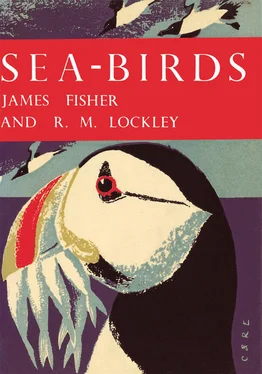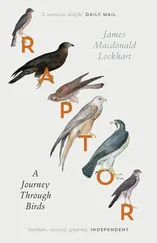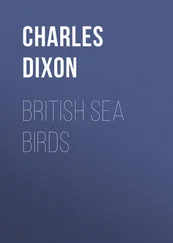The existence of the great auk in the Isle of Man is indicated by a picture of an adult in breeding plumage standing on a ledge on the Calf of Man, drawn by Daniel King, probably in 1652. Williamson (1939), who draws attention to this earliest British depiction of the bird, comments that there is no parallel indication in contemporary Manx literature that the great auk inhabited the Calf. It is quite possible that it may have bred, though this of course is not proved; there are suitable low rock-shelves on the Manx coast on which it could have hauled ashore.
In Orkney one pair certainly bred in 1812. It is not at all certain that the great auk had previously been a regular breeder at Papa Westray (the place of the 1812 nest), or anywhere else in Orkney. The site in 1812 was in a recess low down on the Fowls Craig on this island. The female was killed with a stone while sitting on her egg. In 1813 the male was also killed; it was shot by the native Willy Foulis for William Bullock, the collector, having lived on the ledge after the death of its mate. The natives called them the King and Queen of the Auks (Buckley and Harvie-Brown, 1891).
So much for the great auk in Britain; the last of all, except for St. Kilda’s 1840 ‘witch,’ was an odd bird which was found at the entrance to Waterford Harbour in Ireland in 1834, was kept alive for four months on potatoes, milk, and trout, and which is now in the museum of Trinity College, Dublin.
The early historians of the Faeroe Islands, Ole Worm (1655), who died in 1654, and Lucas Debes (1673), both knew the great auk and handled live specimens caught in the islands. J. K. Svabo (1783) who was in the islands in 1781 and 1782, records the capture of a female on the island of Fugloy which was found on dissection to contain a well-formed egg; and Jørgen Landt (1800, 1810), who wrote his MS. not earlier than 1797, mentions great auks as “climbing up the low rocks.” C. J. Graba (1830), who was in the Faeroes in 1828, met old natives who had formerly seen the great auk at Vestmanna on Streymoy, and one who told him that he had killed one on an egg at this place. J. Wolley (1850) in 1849, interviewed an old man who “had seen one fifty years ago, sitting among the Hedlafuglur, * that is young Guillemots and other birds upon the low rocks, and old men told him it was very rare. This was about the time when Landt wrote.” Wolley was told that formerly, when many were seen, it was considered a sign of a good bird year; which suggests that the auks may have been desultory visitors for a long time. Finally H. W. Feilden (1872) interviewed an old fowler in 1872, who claimed to have killed a great auk on the island of Stóra Dímun on 1 July 1808; the last record for the Faeroes. K. Williamson (1948) points out that none of these records constitutes proof of breeding, though we agree with him that, though scarce, it probably did breed in the Faeroes until the eighteenth century.
The great auks of southern Iceland are well documented, and their history has often been related. They certainly bred on two, and perhaps bred on four Geirfuglaskers , or gare-fowl skerries off the coast; from east to west these can be identified as Hvalbakur , the most easterly point of Iceland, about 26 statute miles east of the island of Papey, near Djúpivogur; Tvísker off Breiðamerkursandur under the great southern ice-cap of Vatnajökull; Geirfuglasker , the southernmost islet of the Westmann Islands, and the most southerly point of Iceland; and (until it sank beneath the waves in a volcanic disturbance in 1830) Geirfuglasker , nineteen or twenty miles south-west of Cape Reykjanes, the most south-westerly point of Iceland save a rock Geirfugladrangur less than a mile further to sea, which still stands but was probably never inhabited by great auks. After the volcanic disturbance the garefowls went for as long as they were spared to the island of Eldey , almost exactly between Geirfuglasker and Cape Reykjanes.
It would seem from the accounts of Ólafsson (1772) and Olavius (1780) that Hvalbakur, the distant whale-back skerry of east Iceland, may have been inhabited by great auks when those historians were in Iceland (between 1752 and 1777); but when N. Mohr (1786) visited nearby Djúpivogur in 1781 he evidently found no news of occupation in that year. If it was true, as Ólafsson thought, that Tvísker (a skerry which at present slopes up to a height of about 46 ft.), was a breeding-place, its occupation must be put before 1764, the last year he was in Iceland; there is no subsequent history here. In the eighteenth century the Westmann islet of Geirfuglasker (which rises to 190 ft., but, as we have seen, has a low platform on one side and low skerries around), had a big colony but, as Friedrich Faber (1822), records, the last known breeding-pair and egg were seen there in about 1800.
The end of the great auk in Iceland, and in the world, took place south-west of Cape Reykjanes. It seems probable that the great auks nested only on Geirfuglasker and afterwards Eldey, and never on the satellite stacks belonging to these rocks—Geirfugladrangur and Eldey-ardrangur. It was known that great auks occupied Geirfuglasker, and were at least occasionally raided by Man, in the first half of the seventeenth century. Though the accounts of the eighteenth century (e.g. J. Anderson, 1746; N. Horrebow, 1752) sometimes slightly conflict it seems clear that Geirfuglasker was occupied in 1729 and that in some years of the first half of that century (if not, perhaps, in that particular year) its great auk population was a “great multitude.” Nevertheless, it could have been exaggerated. Horrebow stated that at his time the Geirfuglasker fowlers “filled their boats with the eggs of the Garefowl.” (All through the early, uncritical literature of fowling we find boatloads of eggs—they have even been allegedly taken from Rockall, where seldom have more than a couple of dozen guillemots been seen in attitudes of incubation.) But a manuscript of c. 1760 (S. Grieve, 1885, p.19) states that the “garefowl is there not nearly so much as men suppose … the space he occupies cannot be reckoned at more than a sixteenth part of the skerry … and this only at the two landing-places; further upwards he does not betake himself, on account of his flightlessness.” Mohr, who visited Iceland in 1780–81, also thought Horrebow’s account exaggerated, though he did not go out to the skerry himself.
In the nineteenth century the doom of the auks was sealed by the raid of the Salamine , a private pirate-ship which had plundered Tór-shavn in the Faeroes on its way north. The crew of this ship was ashore on Geirfuglasker on (it is said) 8 August (? a late date) 1808, and killed many birds and their young. There may have been another raid from the Faeroes in 1809 (H. C. Müller, 1862); there was certainly a big one in 1813, when, during the war between Britain and Denmark, the armed schooner Faeroe landed a party which killed all garefowls that came within their reach, and arrived later in Reykjavik with twenty-four on board, besides numbers that had been salted down; fifty or sixty were taken back to the Faeroes. On 1 July 1821 Friedrich Faber and H. C. Raben visited Geirfuglasker, and Raben actually climbed Geirfugladrangur. They saw no garefowls at all: it is possible that the auks might have already gone to sea (especially if their eggs had already been taken that season). In 1828 at least one adult was taken, for a skin for the Copenhagen Museum. This is the last visit to Geirfuglasker that we hear of; in early March 1830 a series of earthquakes took place in which the skerry sank beneath the sea. The great auks moved at once to Eldey, ten miles nearer the coast, and attempted to breed there in the same season.
Eldey is a remarkable block of volcanic tuff with sheer sides and a flattish top that is distinguished by being the site of the second largest gannetry in the world ( see here). It is about 250 feet high, at its highest point. On the east side of its north end, below the cliff, is a broadish ledge which slopes and slants into the sea ( Pl. IIa), and, as one of us (Fisher) who visited it in 1949 saw for himself, was a suitable landing place and, under the sheer cliff, also a suitable nesting-place for the garefowls. Eldey is made of a particularly resistant type of volcanic tuff; normally such a formation weathers and erodes easily, but Eldey has not significantly changed in a century, * and the Icelanders, who are sensitive to tradition and history, and whose fowlers work with their fathers and sons, are positive that the garefowl ledge is still as it was. It was certainly easy, in 1949, to imagine the great razorbills bobbing buoyantly in the fuss of spray and breakers round the landing-places, clawing a foothold and waddling and struggling clumsily ashore. But they only did this at Eldey for fifteen years. In the first year, the year of the earthquake 1830, two boats took twenty or twenty-one skins for dealers; in 1831 twenty-four were taken; in 1834 at least nine skins and several eggs; in 1840 at least one egg; in 1841 three skins and one egg (the egg was probably laid by a female which laid an egg taken in 1840, judging by their remarkable similarity). On a day between the second and fifth (most probably the fourth) day of June 1844 a boat of fourteen men, under the leadership of Vilhjálmur Hákonarsson, sailed the fourteen miles from Kirkjuvogur to Eldey; the sea was rough, and only three men could get ashore, Sigurður Íslefsson, Jón Brandsson and Ketil Ketilsson. They found two garefowls and an egg. Ketilsson smashed the egg, because it was already cracked, and the others each caught and killed an auk. On their way home the men sold the skins to a certain Christian Hansen, who sold them to the bird-stuffer at Reykjavik, Möller. Since that day no great auk has been certainly seen alive by anybody, anywhere.
Читать дальше












